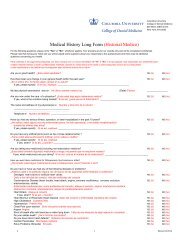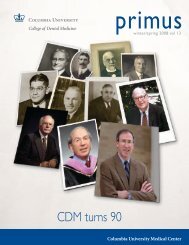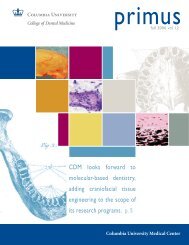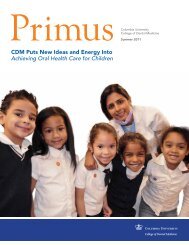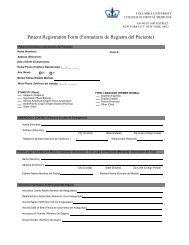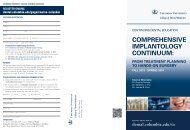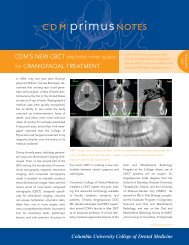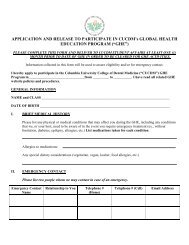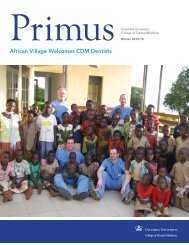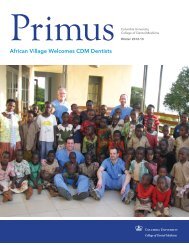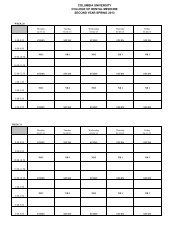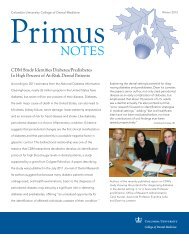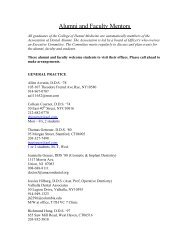Jarvie Journal - College of Dental Medicine - Columbia University
Jarvie Journal - College of Dental Medicine - Columbia University
Jarvie Journal - College of Dental Medicine - Columbia University
You also want an ePaper? Increase the reach of your titles
YUMPU automatically turns print PDFs into web optimized ePapers that Google loves.
Volume 56, Spring 2013<br />
Utilization Patterns <strong>of</strong> <strong>Dental</strong> and Medical Services in <strong>Dental</strong> Patients at Risk for Diabetes<br />
Karla J. Perez 1 , Carol Kunzel 1* , Evie Lalla 1* , Sandra Burkett 1 , Bin Cheng 2 , Ira B. Lamster 2<br />
1 <strong>College</strong> <strong>of</strong> <strong>Dental</strong> <strong>Medicine</strong>, <strong>Columbia</strong> <strong>University</strong>, NY, NY;<br />
2 Mailman School <strong>of</strong> Public Health, <strong>Columbia</strong> <strong>University</strong>, NY, NY<br />
*Faculty Mentor<br />
Introduction: Type 2 diabetes is a serious chronic disease that negatively affects oral health and <strong>of</strong>ten remains<br />
undiagnosed. A larger study aimed to evaluate screening protocols for undiagnosed diabetes and pre-diabetes in<br />
patients presenting at <strong>Columbia</strong> <strong>University</strong> <strong>College</strong> <strong>of</strong> <strong>Dental</strong> <strong>Medicine</strong> (CUCDM) was recently completed. Patients<br />
new to CUCDM were initially screened to target a group at-risk for diabetes. Study participants had to be: ≥40<br />
years <strong>of</strong> age, if non-Hispanic white; ≥30 years <strong>of</strong> age, if Hispanic or non-white; never have been told that they had<br />
diabetes or pre-diabetes; and had to self-report at least one <strong>of</strong> the following diabetes risk factors: family history <strong>of</strong><br />
diabetes, hypertension, overweight/obesity, high cholesterol.<br />
Objective: Our objective was to analyze the demographic characteristics and medical and dental utilization patterns <strong>of</strong><br />
this high-risk patient population in order to obtain a better understanding <strong>of</strong> their co-utilization <strong>of</strong> medical and dental<br />
health services.<br />
Materials & Methods: Participants were asked to fill out a questionnaire regarding their demographic characteristics<br />
(age, race, education), utilization <strong>of</strong> dental and medical services (frequency <strong>of</strong> visits, length <strong>of</strong> time since last visit),<br />
health insurance, health-related habits (smoking) and presence <strong>of</strong> readily reported risk factors for diabetes. Those<br />
who fulfilled the entry criteria described above received a chairside HbA1c finger stick test and a periodontal<br />
examination. A diagnostic blood test (fasting plasma glucose or hemoglobin A1c) was used to define metabolic<br />
status (healthy, pre-diabetes, diabetes). Available test results were reviewed with each patient at the conclusion <strong>of</strong> the<br />
screening process.<br />
Results & Conclusions: A total <strong>of</strong> 1097 subjects were included in the current analysis. The majority were<br />
Hispanic (67.4%), female (64.4%), and had Medicaid as their dental (66.7%) and medical (57.7%) insurance. The<br />
most prevalent risk factor was being overweight or obese (78.6%). Based on the diagnostic blood test result, 75.8%<br />
<strong>of</strong> participants were considered to be healthy, while 17.9% were found to be pre-diabetic and 6.3% diabetic. A<br />
periodontal examination indicated that 37% <strong>of</strong> participants had 25% or more <strong>of</strong> their teeth with at least one<br />
periodontal pocket ≥5mm. Study data further indicated that study participants were more active users <strong>of</strong> medical<br />
services than <strong>of</strong> dental services, with 83.2% visiting their physician for an exam/physical every year, compared to 59.2%<br />
visiting their dentist/hygienist that <strong>of</strong>ten. When the frequency <strong>of</strong> visits was combined with time since last visit, in<br />
order to create a measure <strong>of</strong> intensity <strong>of</strong> medical and dental utilization, 69% <strong>of</strong> participants had high intensity medical<br />
utilization, while 29% had high intensity dental utilization.<br />
Discussion: Preliminary analyses indicate that these dental patients, identified as at risk for undiagnosed diabetes, are<br />
frequent users <strong>of</strong> medical services. Study data further suggest that visits for medical care, although prevalent, may be<br />
narrowly focused, limited to the patient’s presenting complaint, and that some underlying systemic risk factors may be<br />
overlooked. This interpretation suggests that the dental practice setting can provide an important opportunity to identify<br />
individuals unaware <strong>of</strong> their diabetic status, as well as potentially a number <strong>of</strong> other systemic diseases. While the<br />
majority <strong>of</strong> study participants were found to be healthy, all <strong>of</strong> the participants had one or more modifiable risk factors<br />
that could be detrimental to their metabolic and cardiovascular health. Informed by the considerable literature on<br />
models <strong>of</strong> health care utilization, further analysis <strong>of</strong> this data can help us understand the rationale for the pattern <strong>of</strong><br />
co-utilization <strong>of</strong> medical and dental health care services followed by these patients.<br />
This research was supported by grants from Colgate-Palmolive and the New York State Health Foundation.<br />
Karla Perez was supported by a <strong>College</strong> <strong>of</strong> <strong>Dental</strong> <strong>Medicine</strong> Pre-Doctoral Summer Research Fellowship.<br />
39



